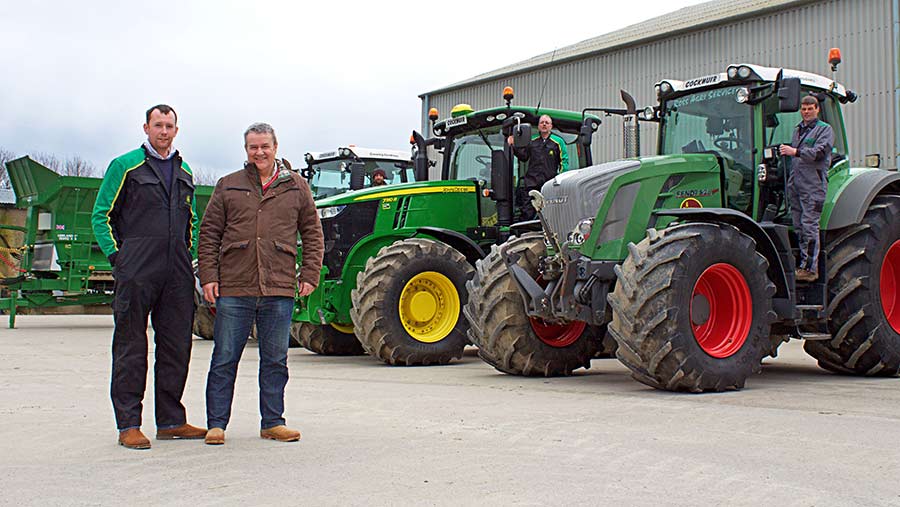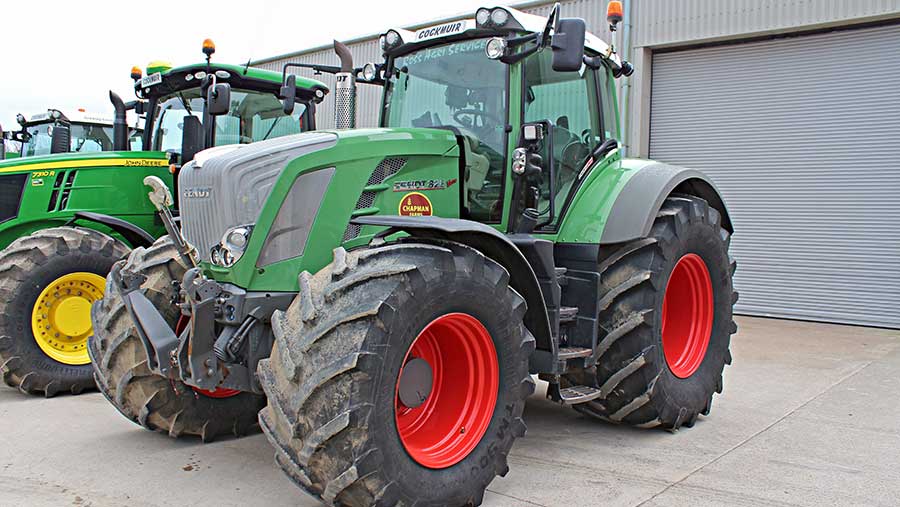What’s in Your Shed? visits an Aberdeenshire farmer
In the latest from our series that takes a look behind the doors of the nation’s machinery sheds we visit Aberdeenshire farmer Iain Chapman.
Find out what’s the best tractor – and the worst – he’s ever owned, what gems he’s got hiding out behind the shed doors and an embarrassing and machinery-related mistake that left him with a hefty bill.
How brand-loyal are you?
We’re not loyal to any brands and we have four different makes of tractor on the fleet. A few years ago we switched to Fendt, but the latest purchase was a John Deere as we were offered a much better deal. The Fendts are probably better tractors, though.

Iain Chapman and Robert Chapman © James-Andrews
Favourite dealer?
Ross Agri at Turriff is probably our favourite and that’s where all our Fendts have come from, as well as the Rogator we have just bought. They always give us a good service and nothing is ever too much trouble. We have also had good dealings with Groundwater Lift Trucks at Stonehaven, where we get our Manitous.
See also: What’s In Your Shed? Norfolk arable farm opens its doors
Favourite piece of kit?
We bought a new Bunning Lowlander 150 during harvest last year and it has been brilliant. Because of the chickens we’ve got serious amounts of muck to shift, so it’s crucial to have a decent spreader.
We also specced it with GPS and weigh cells so that we can do variable rates. The fact that we put so much muck on means we never have to apply artificial P and K, so it’s worth taking the time to put it on properly. We also store all our muck in a shed so that it doesn’t leech or lose any of its nutrient value.
We have been particularly impressed with how evenly it spreads and it will easily fling the muck to 28m so we can run up the tramlines.
Least favourite machine?
Farm facts
Chapman Farms, West Cockmuir, Strichen, Fraserburgh, Aberdeenshire
Livestock: 220-head suckler herd and 200 fat stock; 260,000 laying hens and 170,000 chicks
Arable: 680ha split between winter wheat, winter and spring barley and winter oilseed rape
Other: Egg-packing centre, processing 3.5m to 4m eggs per week; 800kW wind turbine; 200kW of solar panels, three biomass boilers
Staff: Iain, father Robert and eight others, plus 32 in the egg-packing plant
Before the Bunning we had a pair of 16t Rolland machines that we had hung on to for a bit too long and they were incredibly unreliable.
One was a 2003 model and the other a 2005, and they both suffered from broken gearboxes and bed chains – usually when you had just filled it to the brim. I have lost count of how many times we had to fork it all back out.
Latest purchase?
Our John Deere 7310R Autopowr is the most recent arrival and we have been pleased with it so far.
It’s a bit too early to give any decent comment on its performance, but because it’s a wee bit heavier than the Fendt it seems to grip better on the plough.
There’s no doubt the Fendt it a slicker machine to drive, though.
The main reason we bought the Deere was that at £150,000 it was £10,000 cheaper than the Fendt 828 we were also pricing up.
Oldest machine?
We haven’t got anything really ancient, so the oldest machine is a 2007 Manitou 634 telehandler. The clock broke a while ago, but we reckon it’s on about 8,000 hours.
Our telehandlers get worked pretty hard on mucking-out duties so we change them fairly regularly, but this one has stayed as it has been particularly good. It did have to have a new head gasket after about 5,000 hours, though.
It’s on its third set of tyres, which are always Michelins as we’re convinced they last the longest.
How long do you keep your machines?
Most machines are bought with a five-year warranty and we do try to change them when that expires. However, sometimes we will hang on to a machine a wee bit longer if it has been performing well.
The Case-IH 195CVX warranty ran out last year and one of the Fendts is up next year, so we will have to work out what we are going to do with them.
What’s next on your wish list?
It’s getting a bit tedious trying to plant 680ha with a 4m drill, so we are looking to go up to a 5m or 6m folding power harrow combination. We’re sticking with this method as it’s the most reliable system we have found for the catchy conditions we get up here.
We drill with a front press and we can go straight into the ploughed-and-pressed ground. At the moment we are torn between another Amazone or a Lemken Solitair.
Most embarrassing machinery mistake?
Several years ago I managed to turn a load of woodchip over when going round a roundabout on the outskirts of Ellon. Thankfully there was very little damage done to the tractor or trailer, but we had a massive bill from the council to fix the damage to the road surface. It wasn’t a fun job clearing it all up, either.
Most expensive repair bill?
In the shed
Tractors: John Deere 7310R; Fendt 828 x 2; Case-IH CVX195; McCormick X6.140
Combine: Claas Lexion 760 Terratrac with 35ft header
Sprayer: Challenger Rogator 655B with 30m booms
Telehandlers: Manitou 634 x 3 and 741
Trailers: 16t Richard Western trailers x 2 and 20t Richard Western chaser bin
Cultivation kit: Six-furrow Lemken plough with press; five-furrow Kverneland plough with press; 15m Opico Cambridge rolls
Drill: Amazone 4m power harrow combination
Muck spreader: Bunning Lowlander 150
Baler: Lely Welger RP435 round baler
Lorries: DAF XF 510 with bulk trailers
We had a terribly wet harvest the year we bought our Claas Lexion and we had a nightmare trying to cut flat, wet corn with the 35ft header.
We put so much soil up it, we bunged up several of the augers and damaged the belts, too – it was soul-destroying to have to do that to a brand-new combine.
After we had finished we got our dealer to sort it out, which involved pulling out all the augers, cleaning them off and replacing most of the belts.
It took two fitters about 10 days to do it and the bill was more than £6,000.
Best invention?
We built a mobile cattle handling race out of an old crush and a load of scrap we had lying around.
It’s about 25ft long and has two wheels that drop down at the back and a drawbar on the front so that we can tow it between fields. Because our ground is quite spread out it has been a godsend and has saved us loads of time hauling gates around.
It cost us £1,000 to put it together and an off-the-shelf equivalent would be about 10 times that.
What couldn’t you live without in the workshop?
The MIG welder and our Milwaukee ¾-inch impact wrench. The impact gun is amazingly powerful and will whizz wheel nuts off in no time.
We have also recently bought an electric grease gun, which is so much easier than using a manual one.
Do you buy second-hand?
We do buy a few machines second-hand and the last one was the Challenger Rogator. We really wanted a new self-propelled machine, but just couldn’t justify the £200,000-plus price tag, particularly as we had nothing to trade in.
In the end we bought a tidy 2013 machine for £109,000, which was a massive discount for a machine that had done only three seasons of work. We also buy the odd machine through private sales or local collective auctions.
Favourite job?
Combining.
Least favourite?
Combining in a year such as 2014, when we almost destroyed the combine.
What’s your everyday transport?
I’ve got a 2013 Land Rover Discovery 4 Commercial that has been excellent. I had a Discovery 3 before, which suffered the usual suspension faults, but thankfully this one has been much better.
It has done 45,000 miles so far without any serious ailments. Fuel economy isn’t the best, though – I do a lot of short journeys and have a fairly heavy right foot so struggle to top 20mpg.
Best tractor you’ve ever had?

Fendt 828 © James Andrews
That’s a tie between the two Fendt 828s, which are great to drive and haven’t given us any trouble – other than one having to have a new exhaust manifold. We’ve got a 2013 model on 3,000 hours and the other is a 2015 on 2,000 hours. The only problem is that they’re so expensive.
Worst tractor you’ve ever had?
A Marshall 804 that we inherited when we bought a block of land. We thought it would be fine to run on a straw bedder, but the turbo and the clutch went, which probably cost more to repair than the tractor was worth.
Biggest machinery bargain?
We managed to pick up a 6m McConnel topper at a local auction for just £800. It’s in fantastic condition and it would have cost about £20,000 new.
Any machinery classics in the shed?
We’ve got a Fordson Super Major that has been on the farm for years. We had it restored in 2013, but sadly it spends most of its time in the shed.

